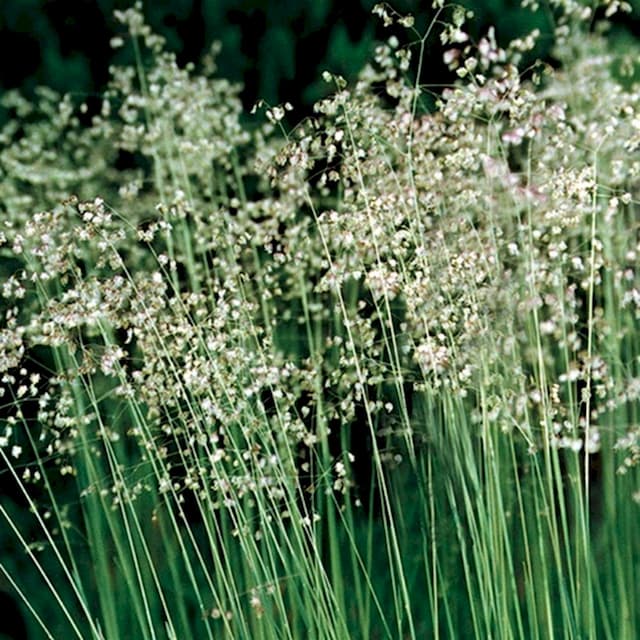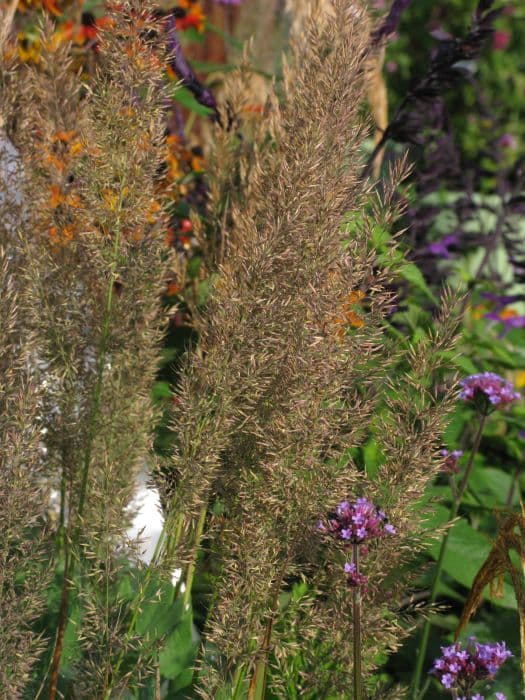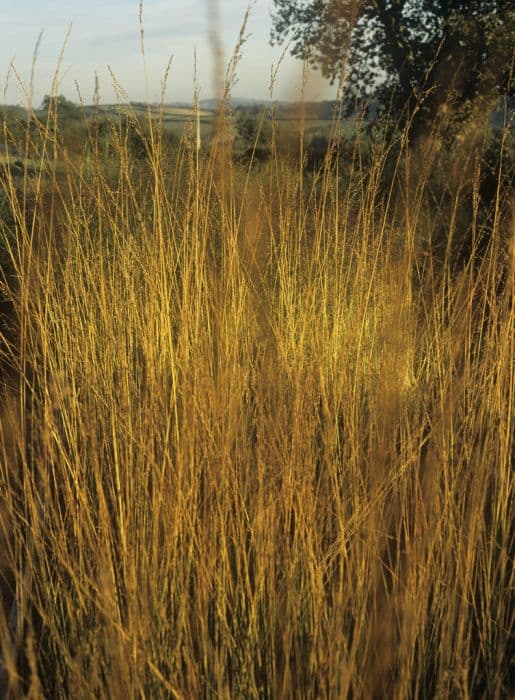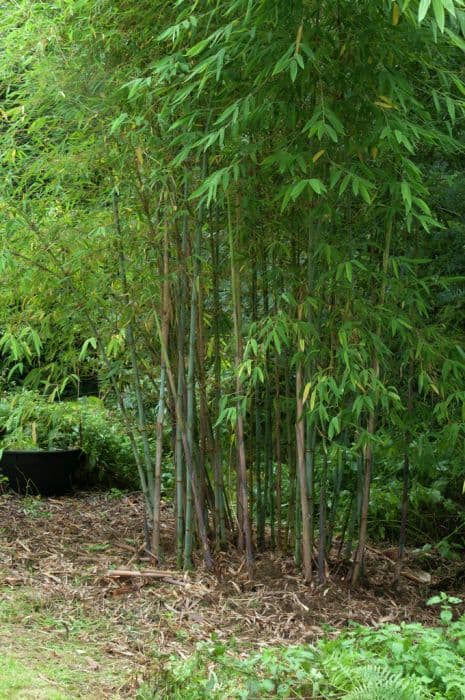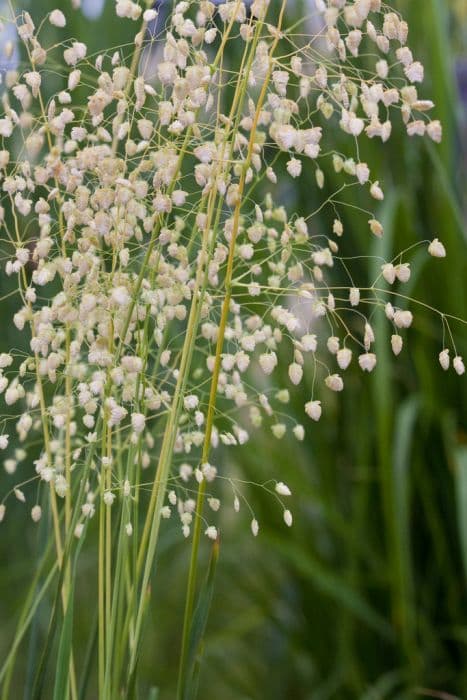Magellan Wheatgrass Elymus magellanicus

ABOUT
Elymus magellanicus, commonly known as Magellan wheatgrass, is a perennial grass with a striking appearance that makes it a favorite in ornamental gardens. This plant is characterized by its narrow, erect, and steel-blue leaves that converge into a neat, tufted form. The blue foliage often has a metallic sheen, lending a unique texture and color contrast to plantings. During the blooming period, the plant produces grain-like flower spikes that emerge above the foliage, bearing a resemblance to typical wheat spikes, but with a decorative flair. The flowers are typically a soft, creamy color, subtly complementing the bold blue of the leaves. Magellan wheatgrass has a relatively rugged look, with leaves resembling blades that can create an almost spiky effect when viewed from a distance. The overall form of the plant is clump-forming, making it an excellent choice for adding structure to garden designs. Its distinct color and form often make it a focal point in gardens, especially when planted against a backdrop of green or among plants with contrasting foliage or flowering plants to highlight its striking coloration. Despite the absence of size specifics, Elymus magellanicus is known for its adaptability and can thrive in a variety of garden settings where its color and form will stand out.
About this plant
 Names
NamesFamily
Poaceae
Synonyms
Magellan Wheatgrass, Blue Wheatgrass
Common names
Elymus magellanicus
 Toxicity
ToxicityTo humans
Magellan Wheatgrass (Elymus magellanicus) is not widely known for its toxicity to humans. There is limited information suggesting that this plant is poisonous or harmful if ingested. However, as with many plants, individual allergies or sensitivities may exist, and it's always prudent not to ingest plants unless they are known to be safe and are prepared properly.
To pets
Magellan Wheatgrass (Elymus magellanicus) is also not known to be toxic to pets. There is scarce information on its toxicity in domestic animals, and it's generally not considered to be a plant of concern in this respect. However, pets can react differently to various plants compared to humans, so it's wise to monitor your pet and consult a veterinarian if they consume any plant material and exhibit unusual symptoms.
 Characteristics
CharacteristicsLife cycle
Perennials
Foliage type
Evergreen
Color of leaves
Blue-green
Height
2 feet [60 cm]
Spread
1 feet [30 cm]
Plant type
Grass
Hardiness zones
5
Native area
South America
Benefits
 General Benefits
General Benefits- Ornamental value: Elymus magellanicus, commonly known as Magellan's wheatgrass, adds visual interest to gardens with its striking blue-green foliage and architectural form.
- Drought tolerance: Once established, it can survive with minimal water, making it suitable for xeriscaping or drought-prone areas.
- Low maintenance: Magellan's wheatgrass typically requires little care once it is established, making it a good choice for gardeners looking for low-maintenance plants.
- Erosion control: The deep root system of Magellan's wheatgrass helps to stabilize soil and prevent erosion, particularly on slopes and in coastal areas.
- Wildlife habitat: The grass provides shelter and nesting material for birds and can be a food source for wildlife.
- Adaptability: It is capable of growing in a wide range of soil types, including poor soils, and can handle full sun to partial shade.
- Seasonal interest: In addition to its summer foliage, Magellan's wheatgrass offers visual interest in the autumn and winter as its foliage and seed heads take on a different texture and color.
 Medical Properties
Medical PropertiesThis plant is not used for medical purposes.
 Air-purifying Qualities
Air-purifying QualitiesThis plant is not specifically known for air purifying qualities.
 Other Uses
Other Uses- Elymus magellanicus, also known as Magellan wheatgrass, can be used as a natural dye source, with different parts of the plant yielding various shades of brown or green.
- The fibrous leaves of Magellan wheatgrass can be woven to create mats or baskets in regions where traditional crafting materials are scarce.
- This grass can serve as erosion control due to its deep root system that helps stabilize soil on slopes and riverbanks.
- Magellan wheatgrass can be planted as a windbreak in gardens or fields to protect other crops from strong winds.
- The ornamental appeal of Elymus magellanicus is appreciated in landscaping for its striking blue foliage, which adds color contrast in garden design.
- In colder climates, Magellan wheatgrass can be used as a winter interest plant, as its foliage maintains structure and color in snow.
- Birds often utilize this grass as nesting material, especially the dry stems and leaves that remain during the plant's dormancy.
- The seeds of Magellan wheatgrass are a food source for ground-feeding birds and small mammals during the fall and winter months.
- This plant can be used in phytoremediation efforts to help restore degraded landscapes due to its hardiness and adaptability.
- In some cultures, the dried stems of Elymus magellanicus are used in traditional ceremonies or as part of floral arrangements.
Interesting Facts
 Feng Shui
Feng ShuiThe Magellan wheatgrass is not used in Feng Shui practice.
 Zodiac Sign Compitability
Zodiac Sign CompitabilityThe Magellan wheatgrass is not used in astrology practice.
 Plant Symbolism
Plant Symbolism- Resilience: Elymus magellanicus, commonly known as Magellan's Wheatgrass, often grows in tough, windy, and salt-sprayed landscapes, symbolizing the ability to withstand challenging conditions and bounce back.
- Adaptability: Its capability to thrive in various soils represents flexibility and the capacity to adapt to changing environments.
- Endurance: The plant's persistence and perennial nature reflect long-lasting endurance and the power of survival.
 Water
WaterMagellan Wheatgrass (Elymus magellanicus) should be watered deeply but infrequently, as it is a drought-tolerant plant once established. Typically, providing about 1 to 1.5 inches of water every week during the growing season is sufficient, but this should be adjusted based on weather conditions and soil type. Overwatering can lead to root rot, so let the soil dry out somewhat between waterings. During the hot summer months, you may need to water more frequently, while in cooler months, less water will be necessary. In terms of volume, this translates to approximately 0.5 to 0.75 gallons per square foot per week, depending on the plant's needs and environmental conditions.
 Light
LightMagellan Wheatgrass prefers full sun conditions to thrive. It should be placed in a location where it can receive at least six hours of direct sunlight daily. Avoid planting it in deep shade, as this will lead to poor growth and a decline in overall plant health. The best spot for this grass is an open, sunny area without tall plants or structures nearby that could create significant shade.
 Temperature
TemperatureMagellan Wheatgrass grows best in cooler climates, with ideal temperatures ranging from 60 to 75°F. It can tolerate a wide range of temperatures but will begin to experience stress if the temperature drops below 20°F or rises above 90°F. Providing the plant with the right amount of water and placing it in an ideal location can help it withstand temperature extremes.
 Pruning
PruningMagellan Wheatgrass should be pruned to remove any dead or damaged foliage and to maintain its shape. Pruning is best done in early spring before new growth begins. This plant does not require frequent pruning; doing so once a year is often enough. If desired, you can also trim it in the late fall to tidy up the plant and prepare it for winter.
 Cleaning
CleaningAs needed
 Soil
SoilFor the best growth of Magellan wheatgrass, the soil mix should be well-draining and rich in organic matter. A mixture of loam, sand, and compost works well. Aim for a soil pH that is slightly acidic to neutral, between 5.5 and 7.0.
 Repotting
RepottingMagellan wheatgrass typically doesn't require frequent repotting. Repotting can be done every 2 to 3 years or when it becomes root-bound to encourage continued growth.
 Humidity & Misting
Humidity & MistingMagellan wheatgrass thrives in average room humidity. It does not require any special humidity conditions, making it adaptable to most indoor environments.
 Suitable locations
Suitable locationsIndoor
Place Magellan wheatgrass in bright, indirect light inside.
Outdoor
Plant Magellan wheatgrass in full sun to part shade outside.
Hardiness zone
4-9 USDA
 Life cycle
Life cycleElymus magellanicus, commonly known as Magellan Wheatgrass, begins its life cycle with germination, which occurs when the environmental conditions are favorable, usually in moist, well-draining soil. Once germinated, the seedlings grow into tufted perennial grasses, developing long, narrow, blue-green leaves that are indicative of its adult foliage. The vegetative stage is marked by clump expansion and tillering as the plant matures. As it enters the reproductive stage, usually in late spring or early summer, it develops tall, slender spikes that bear the flowers and subsequent seeds. After pollination, the seeds mature, which can then be dispersed by wind, animals, or human intervention, completing the cycle. In colder regions, Elymus magellanicus may undergo a period of dormancy during winter months before resuming growth in the spring.
 Propogation
PropogationPropogation time
Spring-Early Summer
Propogation: The most popular method of propagating Elymus magellanicus, commonly known as Magellan wheatgrass, is through seed sowing. Seeds can be started in pots or trays filled with a well-draining seed starting mix. Sow the seeds thinly on the surface and lightly cover them with soil. It is best to do this in the spring after the threat of frost has passed. The soil should be kept moist but not waterlogged, and the pots or trays should be placed in a bright, warm location. Germination can be slow and irregular, so patience is necessary. Once the seedlings have developed true leaves and are large enough to handle, they can be transplanted into individual pots or directly into the garden, spaced about 12 inches (approximately 30 centimeters) apart to allow room for growth.
